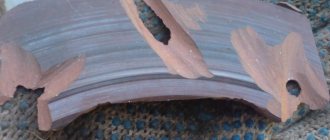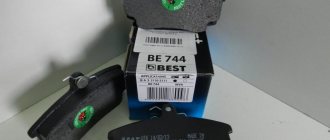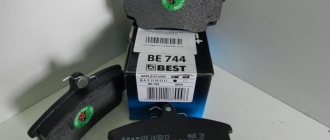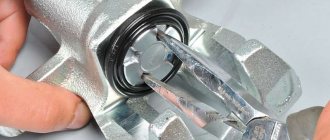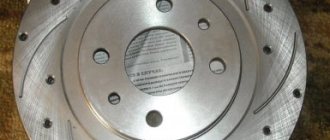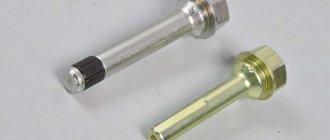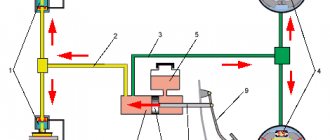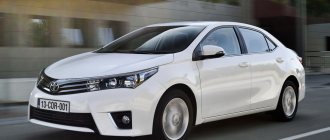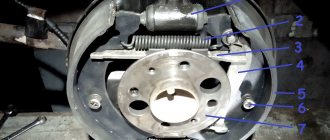A properly functioning braking system is the key to safe vehicle operation. The principle of operation of the system on the Mitsubishi Outlander XL is carried out by transmitting pressure through hydraulics to all wheels of the car due to the mechanical force on the pedal, and if the efficiency of stopping the car decreases, it is necessary to check the brake fluid level in the reservoir and the wear of the pads.
The braking system of the Outlander XL is equipped with an anti-lock wheel system, which increases operational safety - the car obeys every movement of the steering wheel, regardless of the speed of movement or the type of road surface. However, in order for the ABS system to function properly, it is not recommended to skimp on brake pads - budget components will significantly reduce the life of the anti-lock braking system and cause an unpleasant squeak during braking.
When choosing a set of pads for the Mitsubishi Outlander XL, it is advisable to pay attention to original parts or high-quality analogues that are suitable in type and form factor for the car. The optimal solution would be to check the part numbers with the vehicle's VIN code for compatibility on the manufacturer's official website.
| Manufacturer | vendor code | Structural arrangement | Wear indicator | Approximate cost, rub. per set |
| PATRON | PBP1839 | Rear axle | In stock | 720 |
| Abe | PBP1839 | Rear axle | In stock | 840 |
| Abe | C15044ABE | Front axle | In stock | 855 |
| Ashika | 50-05-501 | Front axle | In stock | 940 |
| Asva | AKD-1262 | Front axle | In stock | 940 |
| Asva | AKD-3233 | Rear axle | In stock | 780 |
| Blue Print | ADC44264 | Front axle | In stock | 830 |
When selecting brake pads, it is also necessary to take into account the completeness of the set - in addition to the pads, the package should also contain friction linings, springs and a squeak plate. The last detail plays an important role, allowing timely diagnosis of the exhausted life of the pads and preventing deformation of the brake discs.
Replacing front pads
In order to replace the pads on a Mitsubishi Outlander, it is not necessary to go to a service station. This operation does not require special tools or skills and can be performed by the car owner independently.
To perform the work you should prepare:
- Jack;
- Balloon wrench;
- Key 14 (for Outlander XL key 17);
- 40 cm wire with a cross section of 1.5 - 2.5 mm;
- Special wrench for pressing in brake cylinders. This key is easily replaced with a regular gas key (No. 2 and higher). Or using improvised means, such as a hammer with a wooden handle!;
- A set of new pads (2 pieces per side).
All tools used must be in good working order and comply with the required dimensions. That is, the keys should not be “stretched”, the jack should ensure that the wheel is lifted 2 cm from the surface, etc.
To replace the pads, you need to carry out a number of steps.
- Loosen the wheel nuts.
- Jack up this wheel, unscrew and remove it.
- Using a 14 or 17 wrench, unscrew the bolt on the back side of the caliper (it’s more convenient to unscrew with the appropriate head).
- Turn the caliper outward and tie it with wire (it’s safer to tie it to the stand).
- Remove the old pads from the opened grooves.
- Install new pads in place of the old ones.
- Open the cap on the brake fluid reservoir (this is necessary to ease the effort when squeezing the caliper piston).
- Compress the piston with a special or improvised tool (compression must be done evenly).
- Return the caliper to its place and screw it securely.
- Pump the pedal until it returns elastically.
- Close the lid on the fluid reservoir.
- Reinstall the wheel.
- Repeat all steps exactly on the opposite side of the front axle.
On the Mitsubishi Outlander, all wheels are equipped with disc models. Therefore, replacing the rear brake pads is done in the same way as the front ones. The average service life of the pads is:
- from 30 to 50 thousand km. on Outlander with manual transmission;
- from 25 – 30 thousand km. with automatic transmission.
It is recommended to inspect the entire system every 10,000 km.
Don't be fooled -
Brake pads for Mitsubishi Outlander XL
A properly functioning braking system is the key to safe vehicle operation. The principle of operation of the system on the Mitsubishi Outlander XL is carried out by transmitting pressure through hydraulics to all wheels of the car due to the mechanical force on the pedal, and if the efficiency of stopping the car decreases, it is necessary to check the brake fluid level in the reservoir and the wear of the pads.
The braking system of the Outlander XL is equipped with an anti-lock wheel system, which increases operational safety - the car obeys every movement of the steering wheel, regardless of the speed of movement or the type of road surface. However, in order for the ABS system to function properly, it is not recommended to skimp on brake pads - budget components will significantly reduce the life of the anti-lock braking system and cause an unpleasant squeak during braking.
When choosing a set of pads for the Mitsubishi Outlander XL, it is advisable to pay attention to original parts or high-quality analogues that are suitable in type and form factor for the car. The optimal solution would be to check the part numbers with the vehicle's VIN code for compatibility on the manufacturer's official website.
| Manufacturer | vendor code | Structural arrangement | Wear indicator | Approximate cost, rub. per set |
| PATRON | PBP1839 | Rear axle | In stock | 720 |
| Abe | PBP1839 | Rear axle | In stock | 840 |
| Abe | C15044ABE | Front axle | In stock | 855 |
| Ashika | 50-05-501 | Front axle | In stock | 940 |
| Asva | AKD-1262 | Front axle | In stock | 940 |
| Asva | AKD-3233 | Rear axle | In stock | 780 |
| Blue Print | ADC44264 | Front axle | In stock | 830 |
When selecting brake pads, it is also necessary to take into account the completeness of the set - in addition to the pads, the package should also contain friction linings, springs and a squeak plate. The last detail plays an important role, allowing timely diagnosis of the exhausted life of the pads and preventing deformation of the brake discs.
Difficulties in replacing Outlander XL and 3 pads
There are plenty of difficulties that await a non-professional who undertakes brake repair. We will list just a few of them - the most common ones:
- It is impossible to unscrew the pad mounting bolts. There may be two reasons for this: the fasteners have either become acidic (in other words, they are tightly stuck to the pads themselves due to corrosion), or even worse, they are welded to them. The first occurs when the car is not used for a long time. And if engine parts are protected from moisture by oil, and the body is protected by an anti-corrosion coating, then the pads with all their components, as well as brake discs and drums, are defenseless against rust. In this case, in order to remove parts that require replacement, you will have to use a special liquid that corrodes rust. But if the fastening nuts become welded to them due to the strong heating of the pads during their operation, there is only one thing left: carefully, trying not to damage the discs, cut off the nuts with a grinder.
- The new pads do not fit into their original positions. Replacing brake pads on a Mitsubishi Outlander 3 may require certain components - their choice depends not on the model and year of manufacture of the car, but on the diameter of the wheels and, accordingly, brake discs or drums. And on cars of the same model they can be different depending on the configuration. Therefore, when purchasing new pads, you must take into account, first of all, this parameter.
- It is not enough to simply install new elements in their standard places and secure them. It is also necessary to set the same distance between them and the brake discs (drums). Thus, you will not disrupt the performance of the system for uniform distribution of braking forces, on which not only the efficiency of the car’s braking mechanism as a whole depends, but also the stability of the car on the highway. Otherwise, even if the driver lightly presses the left pedal, the car will skid in one direction or another.
- You should know that replacing the rear brake pads of an Outlander XL is a slightly more complicated procedure, due to the design features of the brakes on the rear axle wheels. They are not disc, like the front ones, but drum ones. In them, in order to get to the parts that require updating, you will have to remove not only the wheels, but also the drums. And adjusting the rear pads will require more skill.
DETAILS: Hyundai Solaris maintenance at an official dealer in Moscow
Installing new rear pads on Outlander XL: step-by-step instructions
Unlike SUVs of the budget category or domestic production, the Mitsubishi Outlander XL is equipped with a disc brake system around the entire perimeter of the vehicle, which significantly increases stopping efficiency and the speed of repair of components. Replacing the rear pads from the front ones on the Outlander XL differs in the location of the brake calipers, which makes some adjustments to the repair algorithm - to install a new set of pads you will need:
- First, you need to drive the car onto a lift or jack up the rear of the car, then unscrew the wheels and provide free access to the brake calipers;
- Next, we unscrew both guides from the caliper - in case of difficult manipulations, it is recommended to treat the parts with WD-40 liquid and leave the structure for half an hour to dry;
- Then we turn the brake caliper inward and remove the old set of pads, having previously disconnected the hook connecting the system to the parking brake;
- Before installing new pads, you need to lubricate the pin and guides, as well as install the springs and squeak plate on a new set of parts;
- Next, we insert fresh pads and mount the brake caliper back, after which we assemble the system in the reverse order. If it is difficult to install the pads, you can use a slotted screwdriver as a lever to push the brake cylinder.
A similar procedure is carried out with the second rear wheel. Replacing brake pads yourself will save up to 1,500 rubles on service station services, and will also speed up the repair procedure.
Timely replacement of brake pads increases the service life of the discs, resulting in reduced costs for scheduled maintenance and vehicle maintenance. Remember, neglecting regular diagnostics and replacing components has a negative impact on all Mitsubishi Outlander XL systems.
What to look for when replacing pads
When performing repair work, it should be taken into account that the pads on the Outlander XL (as well as other modifications of the car) may have uneven wear. The reason lies in the wedging of one of the guides, which is why the caliper acts on the pads with a distortion. By mechanical action, you should check the ease of movement of the guides and replace the defective element.
Before starting work, it is necessary to check the brake disc to ensure that it meets the thickness requirements. For example, its original thickness for the new Outlander XL is 26 mm. The minimum permissible thickness at which element replacement is regulated is 24.4 mm.
You can read more about how to select wheels for a Mitsubishi SUV here.
The thickness of the brake disc is measured with a micrometer. It is recommended to record the measurement in eight areas of the element. In each case the value should be the same, since the wave-shaped disc must be replaced or machined. The distance from the edge to the measuring point should be 1-2 cm.
Replacement of rear brake discs and pads of Mitsubishi Outlander 3 hp.
Brake pads have to be changed quite often, and not only on the Outlander. For some reckless drivers, this procedure is as regular as changing the oil - every 15 thousand km.
So it is not surprising that many car owners, in order to avoid wasting time on trips to a car service center, try to repair the brakes of their cars themselves.
At the same time, forgetting that the braking mechanism is not a system with which mistakes are made. At a critical moment, serviceable brakes can save not only the car itself, but also the life of its driver from an accident.
Replacing brake pads Outlander 3: selection of parts
Brake pads for Outlander from different manufacturers differ not only and not so much in price, but in the composition of their main working element - the so-called friction layer. The durability of the parts and the quality of their work depend on it.
The cheapest are mineral ones. If the Mitsubishi Outlander XL brake pads are replaced with parts of this type, the car owner should know that these parts work better than many others. But, unfortunately, not for long - their abrasion rate is several times higher than, for example, that of standard metal ones.
In addition, mineral pads, the working layer of which is a solid asbestos-containing mixture, are very sensitive to moisture. When wet, they lose more than half of their effectiveness. And finally, their last drawback: asbestos dust formed during abrasion is harmful to human health and the environment.
Although metal pads have lower efficiency, they last longer and are not afraid of moisture. But they are more sensitive to overheating than others. As the temperature rises (and this is inevitable during braking), they begin to work worse, and their wear rate increases.
Partially compensating for this deficiency of metal elements of the brake system is the addition of various resins of organic origin to their composition. These pads are called organic. They cost a little more than traditional ones, but they last a quarter or even half as long as the first ones.
DETAILS: Changing the oil in the Renault Megane 2 engine yourself
Not long ago, some manufacturers replaced resin with ceramic dust and chips. Although this made the parts even more expensive, it almost completely eliminated their temperature dependence and further increased their service life. It is preferable to replace Outlander XL brake pads with parts of this particular type. Their only drawback is their relatively high cost, but given their longer service life, this price is justified.
Replacing pads on a Mitsubishi Outlander
The reason for the replacement was the tedious and constant squeaking of the front pads when braking. At first it appeared only during smooth braking, then it disappeared forever. Due to the circumstances that the original pads of the outs are very “soft”, the mileage of 20,000 did not surprise me, some even change it to 15... In general, Brembo pads were chosen. Why them? No, not because of the name))) there were just a lot of good reviews on them, and the existentialist promised to bring them in 2 days, but they delivered them the next day, which is very pleasing)))
Well, yesterday I climbed into my father-in-law’s warm workshop to replace it... time - 20 minutes, no more) together with removing the wheels - 25.
so, the procedure: 1. jack under this place
I won’t write much, the topic has long been hackneyed and worn out to holes. At TO-45000 I received a verdict - “Wear of the front brake pads is 95%!” The fact that they needed to be changed soon was not a surprise to me, but I was still a little taken aback, because literally 500 km ago I went through a full diagnostic test and there was only 75% wear. This once again confirms the quality of service... even though it is an official dealer. To change means to change. The problem of choosing pads took 3 days to solve. I've read the forums to no avail. I knew one thing - to pay for the original ( 4605A486
) I don’t want it, the price is high - the quality is no better.
As a result, the choice fell on Japanese Advics (SN889)
, especially since, according to some reports, these pads are used as original ones with the MITSUBISHI brand.
At the same time, high-temperature lubricant for the block guides was ordered ( ATE 03.9902-1001.2
)
I drove about 2000 km more before the replacement, but it was one long drive along the highway with a minimum of braking. Before going to the mountains, the pads definitely had to be changed, it would be life-threatening.
Pad wear is very uneven. The remainder is about 3 mm versus 9 mm on different sides, apparently one was wedged.
All plates were removed and brushed, then lubricated and reinstalled. Additionally, I lubricated the anti-squeak plates on both sides. Installed the pads and tightened the pins.
There were some problems. I couldn’t unscrew the guide pin on the caliper and tore off the splines. I had to use a gas wrench. Later, of course, I ordered a new one ( 4605A101
), but for now it’s lying and waiting, most likely I’ll change it when I change the tires.
I drove 10,000 km on new pads. We passed German autobahns, Alpine serpentines, and Italian highways. The impressions are only positive. They don't creak, they don't generate dust. Compared to the previous ones, the braking became clearer and harder, and the softness of the pedal disappeared.
Spare part codes: 4605A486 - front brake pads (original) 4605A101 - caliper guide Advics SN889 - front brake pads (analog) ATE 03.9902-1001.2 - high-temperature grease for guide pads
The “city SUV” from the Japanese auto giant is capable of reaching 200 km/h. Considering the weight of the car (about 1.5 tons), special attention should be paid to the braking system. On a Mitsubishi Outlander, replacing pads and timely maintenance of system elements contributes to long-term, safe operation.
Refinement of the brake system on Outlander XL
The unique combination of dynamic acceleration characteristics and off-road qualities makes the Outlander a car that you don’t want to change. It provokes tender feelings, hurricane emotions and always a great mood. Like a faithful friend, he will take you away from the bustle of the city and pull you out of the slush and despondency of gray everyday life. That is why a number of car owners are trying to equip their pet with the best and most durable.
The fact is that the braking components on the Outlander XL are frankly rather weak. They overheat greatly and wear out quickly. Plus, a single-piston caliper makes its own adjustments to the operation of the braking system. However, car owners who maintain a speed limit of 130 km/h do not show concern about the size of the disc and the number of caliper pistons.
To perform the operation you will need:
- Six-piston Porsche Cayenee calipers;
- Adapter bracket for mounting the caliper;
- 350 mm brake discs from Mitsubishi Lancer Evo 10th generation;
- Matching pads;
- Jack;
- Balloon wrench;
- Heads for 14 and 17;
- Pliers;
- Medium sized hammer.
The purchased parts must be new and of good quality. The price range for such an “upgrade” ranges from 80 to 100 thousand rubles. in a specialized workshop and within 60,000 rubles. at home. The cost can be significantly reduced if you use the BREMBO four-piston caliper as the basis.
Replacement procedure:
- Jack up the wheel, loosen it and remove it;
- Unscrew and remove the brake fluid reservoir cap;
- Remove the caliper completely;
- Disconnect the brake fluid supply hose;
- Remove the brake disc. Very often the disc gets stuck, so the repairman’s hammer and impact equipment will come in handy here;
- Install the caliper adapter bracket;
- Install a new brake disc;
- Mount a new caliper;
- Fill new pads;
- Perform similar actions on the opposite part of the axis;
- Bleed the brake system (bleed air);
- Replace the tank cap;
- Install the wheels in accordance with the covering regulations;
- Make sure all bolted connections are securely tightened.
DETAILS: Car windshield repair in Moscow: prices for repairing cracks and chips in a car windshield
It should be noted that the offset of standard alloy wheels will not allow the wheel to get into place. The new caliper will rest tightly against the wheel rim. Therefore, casting with a large overhang will be required. Or installing spacers and replacing the studs with longer ones. Spacers are selected taking into account the existing rims. On average, they reduce the overhang by 2 cm.
Also, during the conversion process, it is recommended to completely replace the brake fluid with DOT4.
The test results of the new system are impressive. With repeated acceleration to 180 - 200 km/h and sharp braking, the performance of the system remained at its original level. The brake discs have not changed color or become deformed. The braking distance has become significantly shorter. Confidence in the Outlander's abilities, as well as in my own safety, has become higher.
How to Replace Brake Pads on a Mitsubishi Outlander
Brake pad selection
. Reviews. Recommendations.
Akebono
Brembo
Kashiyama
Mintex
TEXTAR
Marcon
Amiwa
Delphi
ROADHOUSE
Trusting
I bought the back pads. The gaskets have 2 roll pins that must fit into the grooves. Didn't get up. Diameter of pins per share mm. More! She gave up and took Korea.
Excellent pads, value for money. There is no violin at all, the covers were installed on new discs. They are even better than the original, mileage is 10,000, not even half of them have worn out. I recommend to everyone, the price is delicious!
There's no more time. They put them on the front wheels, screaming terribly. At first they didn't squeak much, but then I thought my tympanic fractures were going to burst. It was possible to organize competitions with buses that would be louder when braking. The brake is as good, then you can put a plus.
I put it down. In the city, St. Petersburg-Moscow and back without any complaints.
From the very beginning they started to creak at the beginning of braking, but not much. Before this I had the original, no difference in braking dynamics was noticed. But the dust is strong.
Place in front of the new NK disks. Over 10,000 km, a 2 mm brake disc was eaten. Braking performance is good.
Replacing brake pads on Mitsubishi Outlander3, XL, ASX. Front rear With your own hands
Don't be fooled. #LUCKYJunkies. Wheel Hunters.
Replacing Mitsubishi front brake pads. Replacement
Replacement
front
brake pads Mitsubishi
Outlander XL 2008. Replacing the front brake pads
of Mitsubishi
Outlander.
Silent. Dust, especially immediately after installation, then less. When you release the brake smoothly, a noise occurs. Over 20,000 km the yield was 80%.
Shoes are full of crap! I don't know what could be worse. After intense braking, they usually stop clinging to the discs and just float like a clock. It’s very hard, the discs wear out quickly. The brakes are not transparent and difficult to adjust. The only plus. this is a resource due to the stiffness of the pads and the price. After he staged Nishinba, how he was born! I don't recommend this!
I installed it on the front (mileage 51,000 km) along with new FERODO brake discs. They trade confidently, predictably, softly. No extraneous sounds or creaks. At first I wanted to take AKEBONO, but at the last moment I decided on them.
They are brave, but they creak like a cart. Both front and rear, we traveled 1000 km. nothing changed. I'll change.
